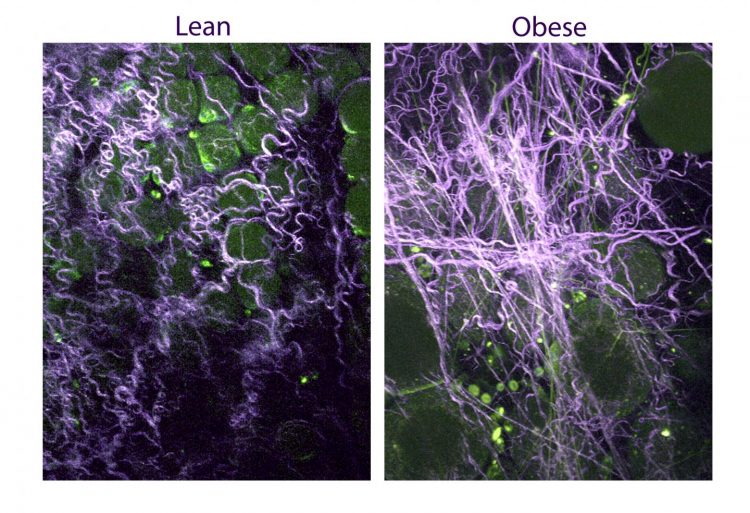Stiffer breast tissue in obese women promotes tumors

Lean vs. obese tissue is shown. Credit: Cornell University
The study of mice and women shows obesity leads to a stiffening of a meshwork of material that surrounds fat cells in the breast, called the extracellular matrix, and these biomechanical changes create the right conditions for tumor growth.
The findings suggest clinicians may need to employ finer-scale imaging techniques in mammograms, especially for obese women, to detect a denser extracellular matrix. Also, the results should caution doctors against using certain fat cells from obese women in plastic and reconstructive breast surgeries, as these cells can promote recurring breast cancer.
“We all know that obesity is bad; the metabolism changes and hormones change, so when looking for links to breast cancer, researchers almost exclusively have focused on the biochemical changes happening. But what these findings show is that there are also biophysical changes that are important,” said Claudia Fischbach, associate professor of biomedical engineering and the paper's senior author. Bo Ri Seo, a graduate student in Fischbach's lab, is the paper's first author.
The study is a collaboration between Cornell's Ithaca campus and researchers at Weill Cornell Medical College and includes Dr. Andrew Dannenberg, professor of medicine.
Fat tissue in obese women has more cells called myofibroblasts, compared with fat tissue in normal-weight women. Myofibroblasts are wound-healing cells that determine whether a scar will form. All cells secrete compounds to create an extracellular matrix, and they remodel and grab onto this meshwork to make tissue. But when myofibroblasts make an extracellular matrix, they pull together – the action needed to close a wound – stiffening the tissue.
But “these are cells in our body regardless of injury,” said Fischbach. In obese women, there are more myofibroblasts than in lean women, which leads to scarring and stiffening without an injury in the extracellular matrix. Tumors also recruit more myofibroblasts than are found in healthy tissue, which also leads to stiffer extracellular matrix.
Many obese women get regular mammograms but signs of disease don't show up because detecting their dense extracellular matrix between the fat cells requires a finer-scale resolution. The findings “may inspire use of higher resolution imaging techniques to detect those changes,” said Fischbach. “Right now, people don't look for stiffer extracellular matrices as a clinical biomarker.”
During plastic or reconstructive surgery following mastectomy in breast cancer patients, doctors may inject adipose stromal cells from obese donors to regenerate tissue. “What our data suggests is that it is really important where these cells are being taken from,” Fischbach said. “If you use these cells from an obese patient, they are very different and you may actually be driving malignancies if you implant them.”
###
The study was funded by the National Institutes of Health, the National Science Foundation, the Breast Cancer Research Foundation and the Botwinick-Wolfensohn Foundation at WCMC.
Cornell University has television, ISDN and dedicated Skype/Google+ Hangout studios available for media interviews.
Media Contact
All latest news from the category: Health and Medicine
This subject area encompasses research and studies in the field of human medicine.
Among the wide-ranging list of topics covered here are anesthesiology, anatomy, surgery, human genetics, hygiene and environmental medicine, internal medicine, neurology, pharmacology, physiology, urology and dental medicine.
Newest articles

Bringing bio-inspired robots to life
Nebraska researcher Eric Markvicka gets NSF CAREER Award to pursue manufacture of novel materials for soft robotics and stretchable electronics. Engineers are increasingly eager to develop robots that mimic the…

Bella moths use poison to attract mates
Scientists are closer to finding out how. Pyrrolizidine alkaloids are as bitter and toxic as they are hard to pronounce. They’re produced by several different types of plants and are…

AI tool creates ‘synthetic’ images of cells
…for enhanced microscopy analysis. Observing individual cells through microscopes can reveal a range of important cell biological phenomena that frequently play a role in human diseases, but the process of…





















